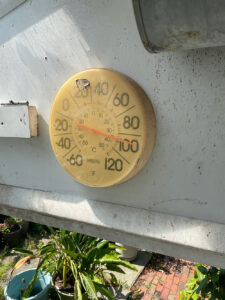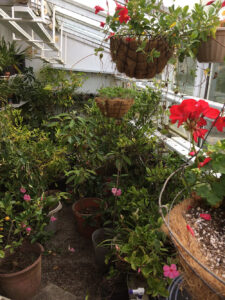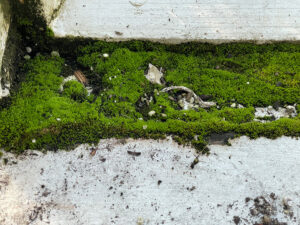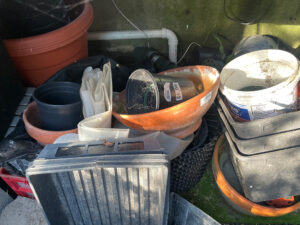
In the dog days of summer, entering the greenhouse is like entering a sauna. Working there, even with the door and windows open, is a form of masochism that even I balk at. But work in it I must. Although my 200+ plants have been moved outdoors, there are still summertime maintenance tasks to do inside the greenhouse. The trick is finding times of day or weather conditions when the interior temperature is not at its peak.
That said, the question was where to start on these summertime chores in my 33-year-old greenhouse? As is usual when the greenhouse is empty, my first job was to thoroughly clean the place by removing all the stray soil, the dead plant matter, and any unwanted growth, such as weeds in beds and moss on benches and shelves.

Beginning around 6am on a Saturday when it was still relatively cool, I tackled this chore and replaced some rotted wood. I also cleaned the insides of the windows. Something that is difficult to do when all the plants are inside. I figured that the outsides of the windows could be cleaned whenever mad dogs and Englishmen were willing to venture out.
Next, I did a little electrical work. With the electrical breaker turned off, electrical boxes that had gotten wet were disconnected, and new watertight boxes were installed. This task was essential to providing reliable power both for lighting and for running the heat mat on cold winter nights. While doing this project, I ran a new wire to my second greenhouse to provide power for its systems too.

I then turned my attention to some reorganization. To give me more repotting space, I relocated the heat mat to one side of the hydroponic system. I also cleaned and stacked a huge pile of unused pots and trays. This gave me space for the bags of potting soil needed for wintertime repotting.
It was now time to attend to any problems with windows and doors. A broken, double-pane, stationary glass panel needed to be ordered, which would take about a week for delivery. Hopefully, I won’t break it during installation like I did the last new glass panel I replaced! While attending to this panel, I also checked all the opening windows and the sliding-glass door to ensure they all worked properly. It’s essential to vacuum sliding-door tracks to eliminate dirt that prevents the door from opening and closing properly. At the same time, I replaced the screen door that I had absentmindedly tried to walk through when it was closed. Screen doors on greenhouses are very helpful to keep out unwanted visitors, referring not to me but to four-footed ones.

My last major job, done on a rainy Saturday morning, was cleaning the hydroponic system and hoses, and then testing it for leaks. Repairing a leak in this system is always a bit of a challenge in that I have to wait for it to dry out before applying a sealer, and by then I’ve often forgotten where the leak is!
With all this work done, my greenhouse is now ready for plants to be put back inside it. But that won’t happen until mid-September after the outdoor temperatures have cooled appreciably.


